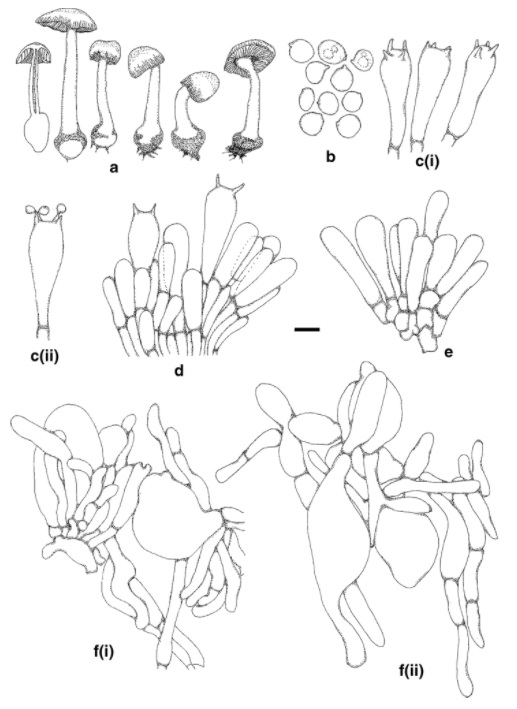Amanita digitosa Boonprat. & Parnmen
Index Fungorum number: IF551619 Faceoffunginumber: FoF 02069
Etymology: The specific epithet refers to Amanita with abundant digitate cell types among other elements of the volva.
Holotype: BBH 32154 Pileus 13.5–29 mm, paraboloid when young, convex to applanate with age, smooth, yellowish brown 5(D–E) 8 at disc, towardshalfofpileusandpaleyellow3(A)4inthemiddleofthe pileus to margin, or the whole pileus yellowish brown 3(A)4, smooth from disctowards thehalf of pileus and striate from the middle of pileus towards the margin, with dry and even margin. Pileus context offwhite, soft. Lamellae free, unequal, subsistent, broad, fimbriate, lamella edge and face paleyellow 3(A)4. Stipe 4.5–6×21–53 mm, central, cylindrical to tapering from base to apex, yellowish white 1(A)2, soft, context reaction yellow with 3%KOH, base bulbous: width 12–16 mm. Annulus not observed. Volva white membranous saccate. Basidiospores 8–10×7–9 [x=8±0.65×9±0.65μm, Q=1.13±0.01, n=25 spores, 1 collection] subglobose, smooth, hyaline, inamyloid, thin-walled, sometimes with wart-like to network-like interior ornamentation. Basidia 30–37.5×10.5–12.5 μm, clavate with 2 and 4-spores, clamp connection absent, smooth, hyaline, inamyloid, thin-walled. Basidioles 16–28×4.7–9.5μm, clavate, smooth, hyaline, inamyloid, thin-walled. Pleurocystidia 31–34×5.5–9.4μm, clavate, smooth, hyaline, inamyloid, thin-walled. Cheilocystidia absent. Lamellae trama divergent, composed of broadly clavate to broadly ellipsoid cells, smooth, hyaline, dextrinoid,thin-walled,base of hymenial layer directly arising from a few layers of cellular cells connected to trama element. Pileipellis composed with cutis of repent hyphae, cylindrical, smooth, hyaline, inamyloid, thin-walled. Stipilipellis composed with cutis of repent hyphae, 3–5μm diam., smooth, hyaline, inamyloid, thin-walled. Stipe trama composed of two types of element: repent hyphae and broadly clavate to broadly ellipsoid hyphae, smooth, hyaline, inamyloid, thinwalled. Volva composed of three types of elements: apex 19–21×base 6μm of digitate cells, 16–68×2.5–8.9μm of clavate cells and 21–32×10.5–23μm of broadly clavate to broadly ellipsoid cells, smooth, hyaline, inamyloid, thinwalled. Clamp absent in all parts of basidiomata.
Habitat: Terrestrial in mixed forest. Material examined: THAILAND, Si Sa Ket Province, Phu Sing District, KhokTan Tambon, 3 September 2012, collector SRRTTeam, Bureau of Epidemiology, Department of Disease Control Ministry of Public Health (BBH 32154, holotype).
Notes: Amanita digitosa differs from A. subfrostiana Zhu L. Yang (1997) in having brown and smaller basidiomata, while in A. subfrostiana they are red over the disc to orange at the margin. Micro-characters include pleurocystidia, while these are absent in the protologue of A. subfrostiana.


